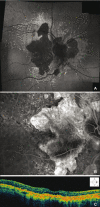Intravitreal avastin for choroidal neovascularization associated with stargardt-like retinal abnormalities in pseudoxanthoma elasticum
- PMID: 21180447
- PMCID: PMC2991464
- DOI: 10.4103/0974-9233.71586
Intravitreal avastin for choroidal neovascularization associated with stargardt-like retinal abnormalities in pseudoxanthoma elasticum
Abstract
The aim of the study was to describe a patient with pseudoxanthoma elasticum (PXE), showing Stargardt-like retinal abnormalities, who underwent treatment with intravitreal bevacizumab for subfoveal choroidal neovascularization (CNV) of the right eye (RE). A 57-year-old woman with diagnosis of angioid streaks, retinal flecks, and chorioretinal Stargardt-like atrophy due to PXE was referred to our department for sudden decreased vision in her RE (20/160). Upon a complete ophthalmologic examination, including fluorescein angiography (FA), and optical coherence tomography (OCT), the patient was diagnosed with subfoveal CNV of the RE. Owing to the subfoveal localization of the CNV, the patient was submitted to intravitreal bevacizumab injection. At the 1-month follow-up, visual acuity (VA) improved (20/40), and FA and OCT revealed the CNV closure. Twelve months after the treatment, the patient's VA remained stable with no recurrence of active CNV. On the basis of our findings, a single intravitreal bevacizumab injection seems to induce total regression of CNV complicating PXE, in a patient showing Stargardt-like retinal abnormalities. Further investigations are required to confirm our results.
Keywords: Avastin; Intravitreal Bevacizumab; Pseudoxanthoma Elasticum; Stargardt’s Disease.
Conflict of interest statement
Figures


References
-
- Bergen AA, Plomp AS, Schuurman EJ, Terry S, Breuning M, Dauwerse H, et al. Mutations in ABCC6 cause pseudoxanthoma elasticum. Nat Genet. 2000;25:228–31. - PubMed
-
- Gass JD. St Louis, MO: Mosby-Year Book Inc; 1997. Stereoscopic atlas of macular diseases: Diagnosis and treatment; pp. 314–25.
-
- Yanoff M, Duker JS. Chap 36. London, England: 1999. Ophthalmology.
-
- Gass JD. “Comet” lesion: An ocular sign of pseudoxanthoma elasticum. Retina. 2003;23:729–30. - PubMed
-
- Agarwal A, Patel P, Adkins T, Gass JD. Spectrum of pattern dystrophy in pseudoxanthoma elasticum. Arch Ophthalmol. 2005;123:923–8. - PubMed
LinkOut - more resources
Full Text Sources

